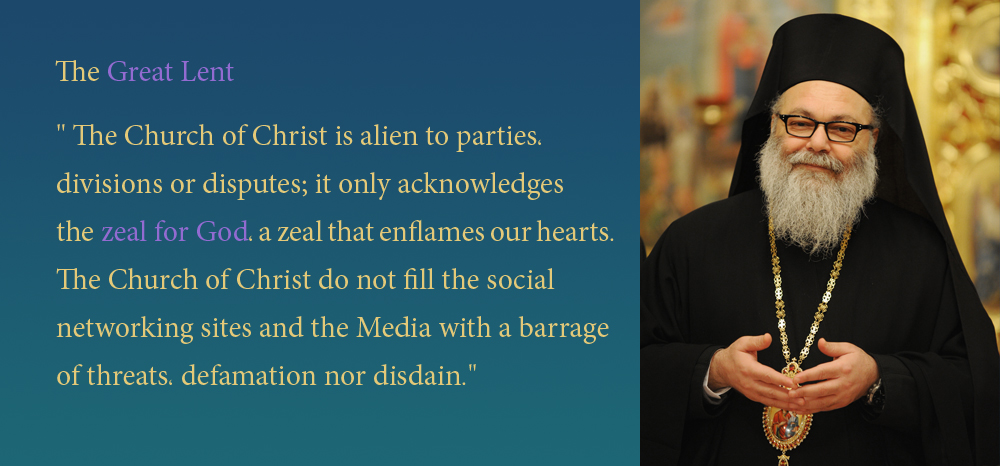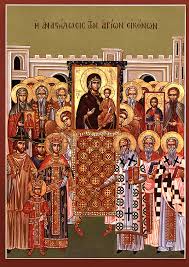The Triumph of Orthodoxy? That sounds brash and prideful, as if we think we Orthodox have beat everybody else out in this “religious game”, that we have all the truth and others have none because we’re so smart and everybody else is so stupid (sounds like modern politics), or that we’ve taken over the world or something. That is not at all what we mean.
Let me explain. But first let’s go back to the beginning.
The Iconoclastic controversy had raged off and on (mostly on) for over 150 years. Holy icons had been taken out of churches, removed from public places, stolen from homes, trampled, burnt, hacked, destroyed in a multitude of ways.
Finally on the First Sunday of Great Lent in the year 843, the Holy Icons were restored to the great Church Aghia Sophia in Constantinople and then throughout the Empire. Ever since, all Orthodox have celebrated this day as the Sunday of Orthodoxy. Over the years the feast has come to be titled the Sunday of the Triumph of Orthodoxy.
So what is this Triumph? We celebrate the victory not only over Iconoclasm, but of Apostolic Faith within the entire Orthodox Church, and its continuity through the centuries.
Let’s be clear: We do believe that the Orthodox Church is the authentic Holy Catholic Church, and that we possess the fullness of the Faith. (We state this positively. We are not “unchurching” anybody else. That’s none of our business.)
Is this a cause for pride? No, it’s reason for humility. We didn’t invent the Faith. It is the gift of God, the holy Tradition passed down to us from Christ and the Apostles. (Do you want evidence of this? Read Church history.) Our job is only to receive it humbly and pass it on unblemished to the next generation.
Nor do we demean the positive gifts of the various denominations and other religions. The Holy Spirit fills the whole world. Nor does any one of us possess all the truth. Each of us sees only a facet of the jewel, which is Jesus Christ. All we believe is that all things must be judged in light of our Lord and God Jesus Christ and his revelation, the Apostolic Faith.
Let’s look at the Triumph that we celebrate this Sunday.
Triumphant in Faith
Since that Sunday almost twelve centuries ago, by the grace of God, the Holy Orthodox Church and all her people have been completely united in the Faith. OK…there was that minor local dustup in the 14th century, which involved only a few theologians and was quickly overcome. And we had an Ecumenical Patriarch who in the 17th century developed some Calvinistic tendencies, of all things. Nobody followed him in this. But that’s it.
This is from Ecumenical Patriarch Bartholomew:

The Orthodox Church has experienced nothing like the divisions and controversies brought on by the Protestant Reformation, and then by Roman Catholic revisionists at various times, all of which continue to this day. When I first looked at the Orthodox Church, I couldn’t believe it. I tried hard to find one Orthodox theologian or bishop or priest or even layperson who denies the Faith. Maybe there are a few hiding behind church pillars, but I couldn’t find any. The Holy Orthodox Church has a unity in Faith and Practice which no other Christian body on earth possesses.
Triumphant on Earth
The Orthodox Church obviously has not conquered the world. So in what way has Orthodoxy triumphed on earth? Because we have been given a wonderful power of faithfulness, continuity, stability, endurance. This, we believe, is a characteristic of The Church, against which the “gates of hell” will never prevail.
The Orthodox Church has endured a lot of “hell”. A few examples: After the dreadful imperial Roman persecution, Orthodoxy triumphed mightily. After the Crusader invasion and the Latin occupation of Byzantium, Orthodoxy emerged still united in her Faith. After four centuries of Turkish Ottoman oppression, when it was illegal even to have an Orthodox school or an Orthodox social institution, Orthodoxy returned united in the Faith. See Greece today. (This would still be true in Turkey if the Greeks hadn’t been chased out. This was not altogether the fault of the Turks.) After seventy years of horrendous persecution by the Communists (at one time there were only three bishops still active in all of Russia and two of those were probably Communist dupes), Orthodoxy emerged powerfully – not without political compromises but with the Faith unaltered. Do you know the ugly story of how the American government tried to destroy Orthodoxy among the native Alaskans? It didn’t work. Today, after over a century living in the West with the subtle enticements of all its various religions and secularisms and nationalisms which have deeply compromised and divided and diminished many other Christian groups, Orthodoxy remains uncompromised, united in Faith and even growing. Those are only a few of the stories.
Only fifty years ago, to talk about the Triumph of Orthodoxy sounded absurd. We were reduced to perhaps 100 million practicing Orthodox in the world, and the Orthodox Church seemed almost headed for  extinction. Today due to the end of Communism and Orthodox growth in the west, there are about 250 million Orthodox. Orthodoxy has triumphed again. I’m sure it’s irreverent to compare the Orthodox Church to the Energizer Bunny, but I’m going to do it anyway… we just keep going and going and going. Sometimes we keep going in different places. The flight of Orthodox a century ago from Greece, then from Communism, and lately from the Middle East has brought Orthodoxy to the Western world – and just in time, I would say.
extinction. Today due to the end of Communism and Orthodox growth in the west, there are about 250 million Orthodox. Orthodoxy has triumphed again. I’m sure it’s irreverent to compare the Orthodox Church to the Energizer Bunny, but I’m going to do it anyway… we just keep going and going and going. Sometimes we keep going in different places. The flight of Orthodox a century ago from Greece, then from Communism, and lately from the Middle East has brought Orthodoxy to the Western world – and just in time, I would say.
This also is none of our doing. It is the gift of God.
With good reason do we celebrate the feast of the Triumph of Orthodoxy.
Icons in the Church
Let’s begin with a look at what led to the victory over the Iconoclasts. We’ll go deeper into this next week.
The word εἰκών in New Testament Greek means both “image” and “icon”. In Genesis 1, man and woman were created in God’s icon, his image. ![]()
Apparently from the First Century on, Christians have made use of holy images, icons. Tradition has it that Christ created the first icon of himself, when he touched a cloth to his face and sent it King Abgar of Edessa to heal his leprosy. This came to be called the Icon Not Made With Hands. This cloth was later taken to Constantinople, then stolen by the Crusaders, and apparently was finally destroyed during the French Revolution.
![]() Tradition also says the first icons of the Theotokos were painted by Saint Luke, when he interviewed the Mother of God, gathering information for his Gospel account. Left: the Vladimir Icon, said to have been “written” by Saint Luke, long ago taken to Russia.
Tradition also says the first icons of the Theotokos were painted by Saint Luke, when he interviewed the Mother of God, gathering information for his Gospel account. Left: the Vladimir Icon, said to have been “written” by Saint Luke, long ago taken to Russia.
None of that is documentable, of course, but it would explain why icons of Christ and his Mother have looked the same from the beginning. There must have been a common source, otherwise we would expect a multitude of early fanciful images of them.
Iconography was something new in our Judeo-Christian Tradition. The only images permitted in the Old Testament were those of  gold cherubim above the Ark of the Covenant in the Holy of Holies in the temple. Exodus 25:18 Otherwise, it was forbidden to make images for religious purposes, since only God was worshipped and venerated, and he dwelt in “inaccessible light whom no man could see or ever can see”. 1 Timothy 6:16 Therefore the Second Commandment: “Thou shalt not make to thyself any graven image of anything in heaven or on earth; thou shalt not fall down to it or worship it.” That seems clear enough.
gold cherubim above the Ark of the Covenant in the Holy of Holies in the temple. Exodus 25:18 Otherwise, it was forbidden to make images for religious purposes, since only God was worshipped and venerated, and he dwelt in “inaccessible light whom no man could see or ever can see”. 1 Timothy 6:16 Therefore the Second Commandment: “Thou shalt not make to thyself any graven image of anything in heaven or on earth; thou shalt not fall down to it or worship it.” That seems clear enough.
But from the beginning Christians did not consider that Commandment binding. Why? Because something new, something unique had happened in Jesus Christ. God “the Word was made flesh, and we have beheld his glory, glory of the only-begotten Son of the Father”. John 1:14 To Philip Christ declared, “He who has seen me has seen the Father.” John 14:9 We have seen “the light of the glory of God in the face of Jesus Christ” 2 Corinthians 4:6 In Jesus Christ God can be seen and can therefore be imaged, “iconed”. Therefore Christians did not  hesitate to have images of Christ. Through them people have been able to participate in what Nathanael experienced when Philip cried to him “Come and see”. John 1:45-46
hesitate to have images of Christ. Through them people have been able to participate in what Nathanael experienced when Philip cried to him “Come and see”. John 1:45-46
But why icons of the saints? Because Christ has restored the tarnished image/icon of God in Adam and Eve, in mankind. Here’s the theology: Christ is present not only in his Body born of Mary, but also in his Body the Church, his holy people. We perceive, know, see, the presence of Christ our God in the saints, and so we have icons of them.
Iconoclasm
There were always a few Christians who were hesitant about icons, who feared idolatry, that people would begin to worship wood and paint. But then in the 8th century came the Iconoclastic movement, These “icon destroyers” claimed that icons are idols, forbidden by the Second Commandment. Why did iconoclasm arise? No one really knows. However, this was at the time of the rise of Islam, those fervent iconoclasts. Some think that the iconoclastic emperors (who were no theologians) concluded that Muslims won their battles because they forsook images.
Just in passing it’s interesting: In the 16th century as the Muslim Turks, iconoclasts, were on the march, here came the Protestant Reformation. And just like the earlier iconoclasts, Christians again threw out images and statues. Was this aspect of the Protestant Reformation also an import (maybe subconsciously) from Islam?
Back to the story.
Iconoclasm was largely a political movement, led by imperial authorities beginning with  Emperor Leo the Isaurian left (his name even sounds nasty doesn’t it?), in the early 8th century. Icons were ordered removed from all public places including churches and destroyed. A few survived, illegally hidden by people in their homes, but many treasures were lost. Most bishops who depended on the emperor’s patronage went along with his iconoclasm. But some brave bishops, most theologians and nearly all monks (who had relatively little to lose) opposed him and his successors. Many were exiled, tortured, some even executed. Likewise it seems most lay people resisted. (“No, you won’t burn the icon my grandmother gave me!”) When Leo ordered a great icon of Christ which hung over a gate of Constantinople torn down and destroyed, there was the first major riot.
Emperor Leo the Isaurian left (his name even sounds nasty doesn’t it?), in the early 8th century. Icons were ordered removed from all public places including churches and destroyed. A few survived, illegally hidden by people in their homes, but many treasures were lost. Most bishops who depended on the emperor’s patronage went along with his iconoclasm. But some brave bishops, most theologians and nearly all monks (who had relatively little to lose) opposed him and his successors. Many were exiled, tortured, some even executed. Likewise it seems most lay people resisted. (“No, you won’t burn the icon my grandmother gave me!”) When Leo ordered a great icon of Christ which hung over a gate of Constantinople torn down and destroyed, there was the first major riot.
Did bishops and monks go to prison and death for the sake of pictures? over works of art? No, of course not. It was because this controversy went to the heart of the Faith. This was not so obvious at first, but then it came clear. The issues were these: 1 Was God really incarnate? Did he take flesh? If so then he can be imaged. In fact as witness to this we need images of Christ. 2 Is the Church truly the Body of Christ? Does Christ live in his people? Then there can be, must be icons of the saints. 3 Is the Church subject to the state? to the whims of politicians? Does the government have the right to tell Christians what to believe? No way. That is why the Church fought back.
In the year 787 Orthodox bishops, during a time of peace, held the Seventh Ecumenical Council which condemned Iconoclasm in no uncertain terms. That didn’t settle the matter. Other iconoclastic emperors came to the throne.
The Restoration of the Holy Icons
 Then in 842 the new Regent Empress Theodora and the Patriarch Methodios called a Synod which restored the Holy Icons. On February 19, the First Sunday of Lent, there was a procession carrying the Icons back into the great church Aghia Sophia. And the Synod fixed the First Sunday of Lent each year as the Sunday of Orthodoxy. And so it still is.
Then in 842 the new Regent Empress Theodora and the Patriarch Methodios called a Synod which restored the Holy Icons. On February 19, the First Sunday of Lent, there was a procession carrying the Icons back into the great church Aghia Sophia. And the Synod fixed the First Sunday of Lent each year as the Sunday of Orthodoxy. And so it still is.
Since then the Holy Orthodox Church has been united in the Faith. Certainly we find things to argue about: the color of the church doors, what language to worship in, who has jurisdiction over the Ukraine, some minor religious matters. But about the essentials of Faith, Orthodoxy from one end of the earth to the other has remained at one.
And so over the centuries this feast has come to be called the feast of the Triumph of Orthodoxy
You Orthodox, don’t let our unity in the Faith go to your head. To repeat, this is by no virtue of ours. God knows we Orthodox often don’t have our act together – today’s division between Moscow and Constantinople, for one sorry example. But even there both Patriarchates are entirely united in the Faith. This is merely a political division. And we Orthodox certainly have our fair share of sinners and screwballs. (Search out “Orthodoxy” on the internet. No, don’t.) The unity of Orthodox in the Faith, the Triumph of Orthodoxy is the gift of God. It is miraculous. It is the work of the Holy Spirit in his Church.
Looking Towards the Future
Now let’s turn around and look ahead. We live in an age of images. This began with modern printing – first tintypes, and then easy access to illustrations and even movies. When I was young, Life Magazine was popular since it contained pictures of everything fit to print. Now we have television, computers, smartphones and more. Today the little images I push on my computer to give access to websites are even called “icons”.
Protestants (long ago) and lately even Roman Catholics have removed images from their churches. How peculiar. How irrelevant. This is “the age of images”. Dear Protestant and Roman Catholic friends, get with it! Put the images back. Catch up with the times!
![]()
But the Orthodox Church is ready for the modern age. Our churches are filled with images, icons, a multitude of them, ready for people to “come and see”.
So on this first Sunday of Great Lent, 2019, as we Orthodox march around our churches, we are not just carrying icons into Aghia Sophia in Constantinople long ago. We are also carrying Orthodoxy, united, triumphant – the Faith as it always has been, is now and will be unto ages of ages – into the 21st century world, relevant as always in this “age of images”.
For as we proclaim at the end of our great Procession of Icons:
“This is the Faith of the Apostles, this is the Faith of the Fathers, this is the Faith of the Orthodox, this is the Faith which has established the Universe.”
The Next Two Weeks: More on “The Theology of the Icon”
